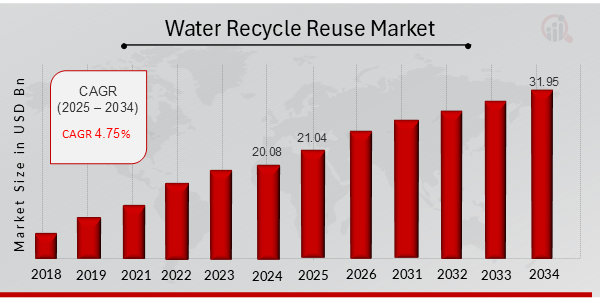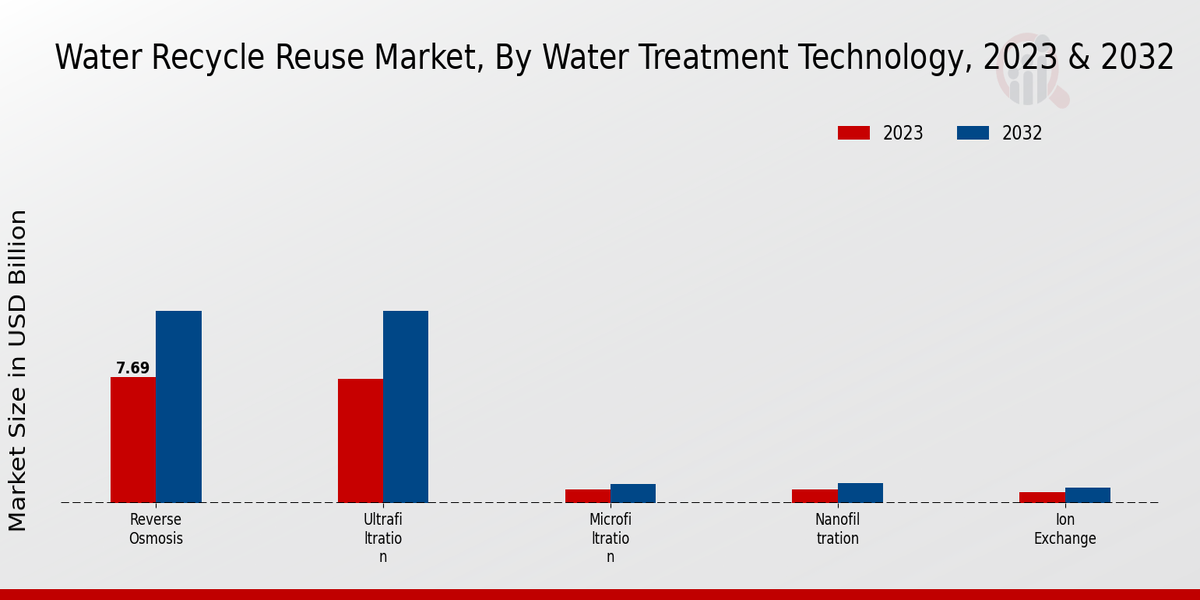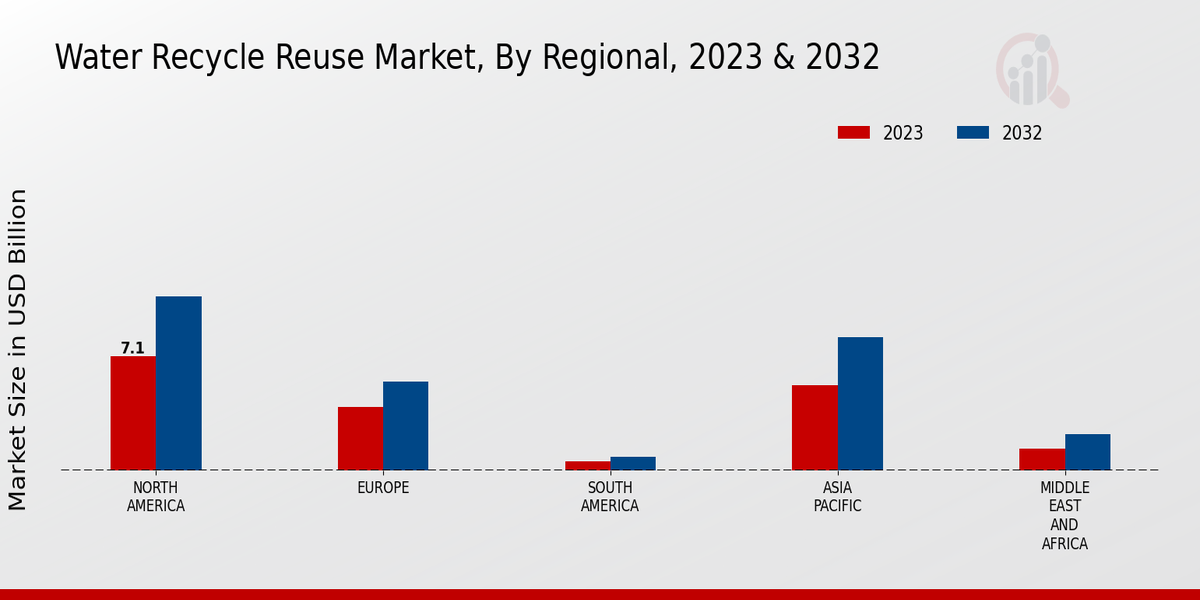Global Water Recycle Reuse Market Overview:
As per MRFR analysis, the Water Recycle Reuse Market Size was estimated at 20.08 (USD Billion) in 2024. The Water Recycle Reuse Market Industry is expected to grow from 21.04 (USD Billion) in 2025 to 31.95 (USD Billion) till 2034, at a CAGR (growth rate) is expected to be around 4.75% during the forecast period (2025 - 2034).
Key Water Recycle Reuse Market Trends Highlighted
Key market drivers for the Water Recycle Reuse Market include rising water scarcity, increasing demand for sustainable water management practices, and stringent government regulations on wastewater discharge. The market also benefits from technological advancements enabling efficient water treatment and purification, reducing the cost and energy required for water recycling and reuse.
Opportunities for growth in the Water Recycle Reuse Market lie in expanding industrial applications, particularly in water-intensive sectors such as manufacturing and mining. Additionally, the development of decentralized water treatment systems and the integration of water reuse into urban infrastructure present significant growth opportunities. The increasing adoption of IoT and automation technologies in water management systems further enhances the efficiency and effectiveness of water recycling and reuse processes.
Recent trends in the Water Recycle Reuse Market include the growing emphasis on water conservation and sustainability, leading to increased investment in water recycling and reuse technologies. Governments and organizations worldwide are actively promoting water reuse initiatives, incentivizing industries and municipalities to adopt sustainable water management practices. The market is also witnessing a shift towards advanced treatment technologies, such as membrane filtration and ultraviolet disinfection, to ensure the safety and quality of recycled water for various applications.

Source: Primary Research, Secondary Research, MRFR Database and Analyst Review
Water Recycle Reuse Market Drivers
Increasing Water Scarcity and Population Growth
Issues water scarcity is one of the issues that has intensified and is projected to be on the rise in the world. In fact, United Nations UN21 projects that by the year 2030, two-thirds of the world’s population will live in areas, which are facing water stress. The shortage of the water resource is attributed to global warming, increased population, and rapid urbanization. It is reasonable to assume that given the emerging shortages, humanity should devise ways to recycle or reuse the precious commodity.
The Water Recycle Reuse Market Industry is expected to expand rapidly primarily due to the intensified critical necessity for the effective conservation of water resources and increased technology usage in recycling and reusing the commodity. Additionally, key to the growth of the market industry is the demand for the resource from the manufacturing, power, and agriculture producers. The Water Recycle Reuse Market Industry is further supported by the intensified government regulations and initiatives on water conservation and sustainability.
Stringent Government Regulations and Policies
Many countries developed strict regulations and policies to stimulate water reuse and recycling. For example, the European Union targeted to achieve a 20 % water reuse by 2025. In the United States, EPA developed guidelines for water reuse and recycling. Ultimately, all these regulations and policies will drive the growth of the Water Purifier Market Industry as both businesses and municipalities are trying to find ways to comply with the new rules.
Technological Advancements and Innovations
The driving factor of growth of the Water Recycle Reuse Market Industry is also the advancements and innovations of technology. For instance, the new membrane technologies are developed and it is possible to recycle water more efficiently and cost-effectively. Plus, new sensors and monitoring technologies enable to track and monitor water quality in real-time and it is crucial to assure that the recycled water is safe.
Water Recycle Reuse Market Segment Insights:
Water Recycle Reuse Market Water Treatment Technology Insights
The Water Treatment Technology segment of the Water Recycle Reuse Market is projected to grow from USD 11.2 billion in 2023 to USD 16.3 billion by 2032, exhibiting a CAGR of 4.2% during the forecast period. Reverse Osmosis (RO) technology is expected to hold the largest market share due to its wide applicability in various industries, including desalination, wastewater treatment, and industrial water treatment. The increasing demand for clean water and the need for efficient and cost-effective water treatment solutions are driving the growth of the RO market.
Ultrafiltration (UF) technology is another significant segment, expected to witness substantial growth during the forecast period. UF is commonly used in water purification, wastewater treatment, and food and beverage processing. It offers advantages such as high efficiency in removing suspended solids, bacteria, and viruses, making it suitable for applications where high-quality water is required. Microfiltration (MF) technology is also gaining traction in the market due to its ability to remove particles and microorganisms from water. This technology is widely used in drinking water treatment, wastewater treatment, and the production of pharmaceuticals and cosmetics.
Nanofiltration (NF) technology, which falls between RO and UF in terms of pore size, is projected to experience significant growth in the coming years. NF is increasingly used in water softening, desalination, and the removal of organic contaminants from water. Ion Exchange (IX) technology involves the exchange of ions between a resin and a solution. It is commonly used in water softening, demineralization, and the removal of heavy metals from water.
The IX market is expected to grow steadily due to its effectiveness in removing specific ions and its applicability in various industries. Electrodialysis (ED) technology, which uses an electrical field to separate ions from water, is anticipated to witness moderate growth during the forecast period. ED is primarily used in desalination and the production of ultrapure water. The growth of the Water Recycle Reuse Market is driven by increasing water scarcity, stringent environmental regulations, and the rising demand for clean water in various industries. The adoption of water recycling and reuse practices is gaining momentum, as businesses and governments recognize the benefits of conserving water resources and reducing wastewater discharge.

Source: Primary Research, Secondary Research, MRFR Database and Analyst Review
Water Recycle Reuse Market Water Sources Insights
The Water Recycle Reuse Market segmentation by Water Sources comprises Municipal Wastewater, Industrial Wastewater, Agricultural Drainage, Stormwater Runoff, Brackish Water, and Desalinated Water. Municipal Wastewater held the largest revenue share in 2023, owing to increasing urbanization and stringent regulations for wastewater treatment. Industrial Wastewater is expected to witness significant growth over the forecast period due to rising industrial activities and the need for water conservation.
Agricultural Drainage is projected to contribute a substantial share to the market, driven by the growing demand for sustainable irrigation practices.Stormwater Runoff is anticipated to gain traction as a viable water source, particularly in regions facing water scarcity. Brackish Water and Desalinated Water segments are expected to experience steady growth as desalination and brackish water treatment technologies become more cost-effective.
Water Recycle Reuse Market Application Insights
Application Segment Insight and Overview The Water Recycle Reuse Market is segmented into various applications, including Municipal Water Supply, Industrial Water Supply, Agricultural Irrigation, Environmental Restoration, and Recreational Water Use. Among these segments, Municipal Water Supply holds a significant share of the market, with a projected 2024 revenue of USD 6.8 billion. This growth is primarily driven by increasing urbanization and population growth, leading to rising demand for clean and safe water sources. Industrial Water Supply is another major application segment, with an estimated revenue of USD 4.3 billion in 2024.
Growing industrialization and stringent water regulations are contributing to the adoption of water recycling and reuse practices in industries such as manufacturing, mining, and power generation. Agricultural Irrigation is expected to witness a steady growth rate during the forecast period, reaching a revenue of USD 3.2 billion by 2024. With increasing water scarcity and demand for sustainable irrigation methods, farmers are adopting water recycling and reuse techniques to optimize water usage and enhance crop yields. Environmental Restoration and Recreational Water Use are also emerging application segments, driven by growing concerns about water pollution and the need for sustainable water management practices.
Water Recycle Reuse Market Application Stage Insights
The Application Stage segment of the Water Recycle Reuse Market is categorized into Pretreatment, Primary Treatment, Secondary Treatment, Tertiary Treatment, and Advanced Treatment. Among these, the Pretreatment segment is expected to witness significant growth in the coming years as it plays a crucial role in removing impurities and contaminants from wastewater before further treatment. In 2023, the Pretreatment segment accounted for a market share of around 25%, and this share is projected to increase to over 30% by 2032. The growth of the Pretreatment segment can be attributed to the rising demand for efficient and cost-effective wastewater treatment solutions, particularly in developing countries where water scarcity and pollution are major concerns.
Water Recycle Reuse Market Process Design Insights
The Water Recycle Reuse Market is segmented by Process Design into Centralized Systems, Decentralized Systems, and Hybrid Systems. Centralized systems are anticipated to dominate the market in the upcoming years owing to their ability to treat large volumes of wastewater effectively and efficiently. They offer centralized control and monitoring, ensuring consistent water quality and meeting regulatory standards. Decentralized systems, on the other hand, are gaining traction due to their adaptability and cost-effectiveness for smaller-scale applications.
Hybrid systems, combining elements of both centralized and decentralized systems, provide flexibility and optimization based on specific project requirements. In 2023, the Water Recycle Reuse Market for Centralized Systems was valued at USD 9.5 billion, while Decentralized Systems held a market value of USD 5.2 billion. Hybrid Systems are projected to witness significant growth, reaching a market valuation of USD 3.1 billion by 2032. These insights highlight the evolving market dynamics and the growing demand for efficient and sustainable water management solutions.
Water Recycle Reuse Market Regional Insights
The regional segmentation of the Water Recycle Reuse Market provides insights into the market's distribution across different geographic regions. North America holds a significant share of the market, driven by increasing water scarcity and stringent environmental regulations.
Europe follows closely, with a focus on sustainable water management and wastewater treatment initiatives. APAC is projected to experience substantial growth due to rapid urbanization and industrialization, leading to increased water consumption and wastewater generation.South America and MEA are emerging markets with growing demand for water reuse solutions to address water challenges.

Source: Primary Research, Secondary Research, MRFR Database and Analyst Review
Water Recycle Reuse Market Key Players And Competitive Insights:
Major players in Water Recycle Reuse Market industry are constantly striving to gain a competitive edge by investing in research and development, expanding their product portfolios, and forming strategic partnerships. Leading Water Recycle Reuse Market players are focusing on developing innovative technologies and solutions that offer improved efficiency, cost-effectiveness, and environmental sustainability. The Water Recycle Reuse Market development is driven by increasing water scarcity, stringent environmental regulations, and growing awareness about the benefits of water reuse.
The Competitive Landscape of the Water Recycle Reuse Market is characterized by a mix of established players and emerging startups.Veolia, a leading Water Recycle Reuse Market player, offers a comprehensive range of water treatment and reuse solutions to various industries, including municipal, industrial, and commercial sectors. The company's expertise in membrane technologies, desalination, and wastewater treatment enables it to provide customized solutions that meet specific water reuse requirements.
Veolia's global presence and extensive experience position it as a trusted partner for water reuse projects worldwide.Xylem, a key competitor in the Water Recycle Reuse Market, specializes in providing innovative water and wastewater solutions. The company's focus on developing energy-efficient and sustainable technologies has made it a preferred choice for water reuse applications. Xylem's Flygt submersible pumps, Sanitaire aeration systems, and Leopold filter media are widely used in water reuse facilities. The company's commitment to research and development ensures that it remains at the forefront of water reuse technology.
Key Companies in the Water Recycle Reuse Market Include:
Water Recycle Reuse Market Industry Developments
The global water recycle and reuse market is projected to grow from an estimated USD 18.3 billion in 2023 to USD 27.8 billion by 2032, exhibiting a CAGR of 4.75% during the forecast period. This growth is attributed to the increasing demand for water conservation and treatment technologies, stringent environmental regulations, and rising awareness about the benefits of water reuse.
Notable recent developments in the water recycle and reuse market include:In February 2023, the European Union launched a new initiative to promote water reuse, aiming to increase the share of reused water in the EU by 20% by 2030.In March 2023, the United States Environmental Protection Agency (EPA) announced new funding opportunities for projects that advance water reuse technologies.
In April 2023, the World Bank approved a USD 500 million loan to support water reuse projects in India.These developments indicate a growing recognition of the importance of water reuse as a sustainable solution to address water scarcity and environmental challenges.
Water Recycle Reuse Market Segmentation Insights
-
Water Recycle Reuse Market Water Treatment Technology Outlook
-
Reverse Osmosis
-
Ultrafiltration
-
Microfiltration
-
Nanofiltration
-
Ion Exchange
-
Electrodialysis
-
Water Recycle Reuse Market Water Sources Outlook
-
Municipal Wastewater
-
Industrial Wastewater
-
Agricultural Drainage
-
Stormwater Runoff
-
Brackish Water
-
Desalinated Water
-
Water Recycle Reuse Market Application Outlook
-
Water Recycle Reuse Market Application Stage Outlook
-
Pretreatment
-
Primary Treatment
-
Secondary Treatment
-
Tertiary Treatment
-
Advanced Treatment
-
Water Recycle Reuse Market Process Design Outlook
-
Centralized Systems
-
Decentralized Systems
-
Hybrid Systems
-
Water Recycle Reuse Market Regional Outlook
-
North America
-
Europe
-
South America
-
Asia Pacific
-
Middle East and Africa
| Report Attribute/Metric |
Details |
|
Market Size 2024
|
20.08 (USD Billion)
|
|
Market Size 2025
|
21.04 (USD Billion)
|
|
Market Size 2034
|
31.95 (USD Billion)
|
|
Compound Annual Growth Rate (CAGR)
|
4.75% (2025 - 2034)
|
|
Report Coverage
|
Revenue Forecast, Competitive Landscape, Growth Factors, and Trends
|
|
Base Year
|
2024
|
|
Market Forecast Period
|
2025 - 2034
|
|
Historical Data
|
2019 - 2023
|
| Market Forecast Units |
USD Billion |
| Key Companies Profiled |
Toray Industries ,SAUR ,Suez ,Aquatech International ,Pentair ,Thames Water ,Kurita Water Industries ,Evoqua Water Technologies ,Severn Trent Services ,United Utilities ,Xylem ,GE Water Process Technologies ,Veolia ,Mitsubishi Chemical ,IDE Technologies |
| Segments Covered |
Water Treatment Technology ,Water Sources ,Application ,Application Stage ,Process Design ,Regional |
| Key Market Opportunities |
Growing demand for waterefficient technologies Increasing water scarcity Government regulations and incentives Technological advancements Growing awareness and adoption of sustainable water management practices |
| Key Market Dynamics |
Increasing water scarcity growing industrial demand stringent regulations technological advancements rising awareness |
| Countries Covered |
North America, Europe, APAC, South America, MEA |
Frequently Asked Questions (FAQ) :
The Water Recycle Reuse Market is anticipated to reach a valuation of approximately USD 20.08 billion in 2024.
The Water Recycle Reuse Market is projected to reach a valuation of approximately USD 31.95 billion by 2034, exhibiting a steady rise over the forecast period.
The Water Recycle Reuse Market is estimated to expand at a CAGR of 4.75% from 2025 to 2034, indicating a consistent growth trajectory.
The Asia-Pacific region is anticipated to dominate the Water Recycle Reuse Market, primarily due to increasing water scarcity, stringent environmental regulations, and government initiatives promoting water conservation.
Water recycling and reuse find applications in various sectors, including municipal, industrial, agricultural, and commercial. It is used for non-potable purposes such as irrigation, cooling, and cleaning, as well as for potable purposes in some regions.
The Water Recycle Reuse Market is characterized by the presence of several key players, including Suez, Veolia, Xylem, Evoqua, and GE Water Process Technologies, among others.
The growth of the Water Recycle Reuse Market is driven by several factors, including increasing water scarcity, rising demand for sustainable water management practices, and supportive government regulations aimed at water conservation and environmental protection.
The Water Recycle Reuse Market faces certain challenges, such as high upfront investment costs, stringent regulatory requirements, and public perception and acceptance of recycled water.
The Water Recycle Reuse Market presents significant opportunities for growth, including advancements in technology, increasing awareness of water conservation, and growing demand for sustainable solutions in water management.
Key trends shaping the Water Recycle Reuse Market include the integration of digital technologies, the development of decentralized water treatment systems, and the increasing adoption of nature-based solutions for water management.

















